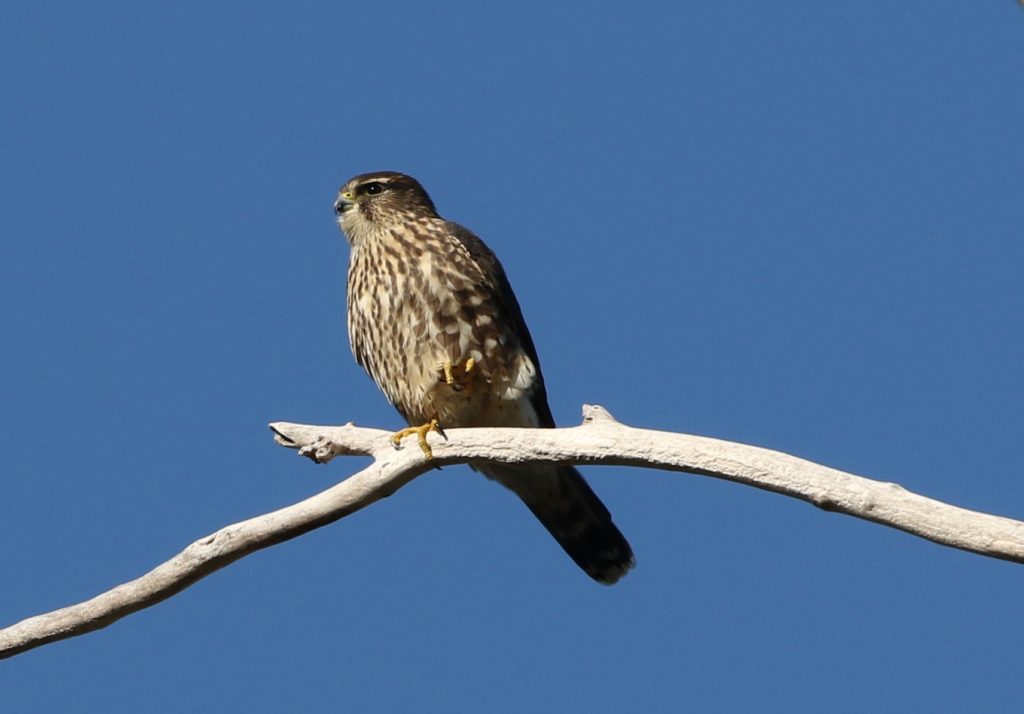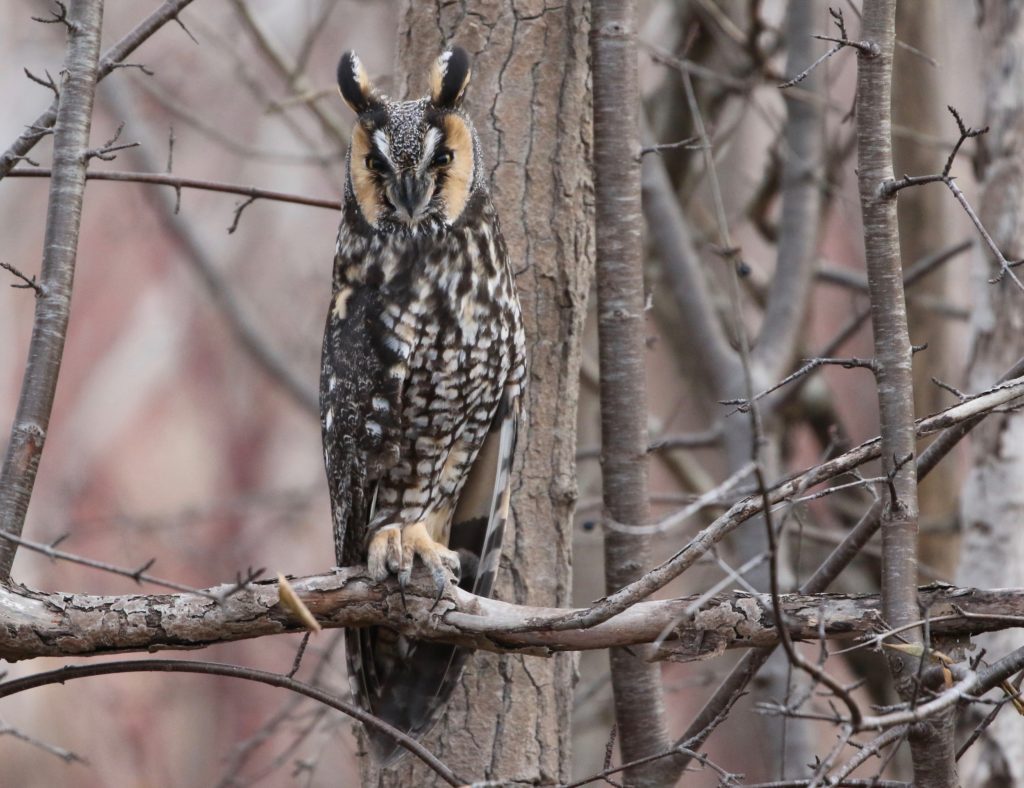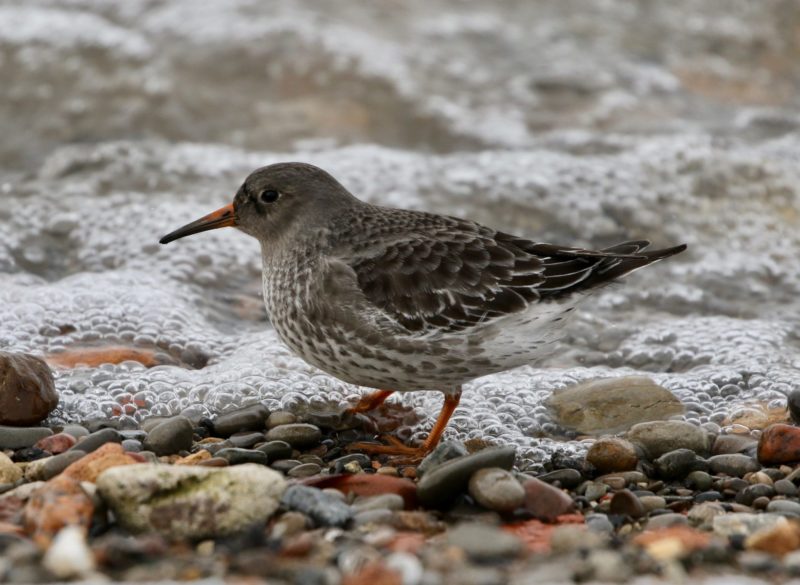To put it as simply as possible: birds display two types of camouflage: color and shape. Both of these techniques help them to perform the magical act of disappearing, of blending into their surroundings, sometimes to the point of invisibility.
In the spring, birds put themselves on display in hopes of finding a mate. During the summer, the thick foliage of the trees where they nest hides them from view while they hatch and raise their young. But once the leaves have fallen, small and medium-sized birds are vulnerable to raptors of every kind, and camouflage is one strategy they’ve developed to protect themselves.
Two species of birds that I see in Toronto almost every winter serve as extreme examples of the two types of camouflage: the Purple Sandpiper (color) and the Long-eared Owl (shape). But it’s worth noting right at the start that each of these examples also incorporates aspects of the other camouflage type, the sandpiper of shape, and the owl of color.
Purple Sandpiper

This bird nests on barren tundra in the high arctic, but in winter it seeks out rocky shorelines or coastal jetties where waves crash on algae-covered rocks. It feeds on a variety of small creatures that inhabit the algae or that live among the stones scattered along a rocky beach. Crustaceans, worms, insects, and spiders all form part of its diet.
This sandpiper’s plumage is so cryptically colored that the field guide authors can’t agree on how to describe it. The National Geographic Guide calls it “slate gray.” Pete Dunne says it’s “bluish brown.” And David Sibley contents himself with calling it “dark.” Everyone agrees, however, that in a good light, there’s a distinct “purplish sheen” that’s unique to this bird and gives it its name.
The purple-gray-blue-brown-whatever cast to its plumage makes this sandpiper hard to see when it’s feeding on wet rocks, and it can fade completely from view when at rest on a pebbled shore. The bird has a stubby neck and short legs. Its small size and circular body shape also help it to blend in with the multi-colored pebbles, as you can see in the photo above.
In winter, the only bright spots on the Purple Sandpiper are its orange legs and the similarly colored base of its bill. This orange-purple combination may be subdued, but it’s strangely pleasing to the eye, once you’ve managed to separate the bird from its surroundings.
The Purple Sandpiper nests farther north than any other shorebird, and perhaps for that reason, it’s always the last shorebird species to migrate through Toronto in the fall. It doesn’t usually appear till the end of November, and we only see two or three a year, sometimes none at all, since most of these birds spend the winter along the East Coast.
In migration, Purple Sandpipers are vulnerable to Peregrine Falcons, Merlins, Goshawks, and other raptors, including Snowy Owls. However, their dark plumage seems to give them an edge over similarly sized but lighter-colored shorebirds such as Dunlin and Sanderling.

Long-eared Owl

The Long-eared Owl has a habit of growing thinner and taller whenever it feels threatened. Most guide books show two pictures of this owl: one in its normal, somewhat squat and thick-bodied stance, and another in its elongated “camouflage posture.”
Until you see one in the wild, it’s hard to imagine just how insubstantial a Long-eared Owl can make itself. While at rest, it resembles a small, discount-version of the Great Horned Owl, but once it’s assumed the camouflage posture, it becomes so willowy and thin that, as Pete Dunne notes, it looks like “a Great Horned painted by El Greco.”
What’s the point of all this posturing? The owl is trying, of course, to turn itself into a stick, so that its profile won’t make it easy to spot in the branches of an alder or a Russian olive, two of its favorite roosting sites. It doesn’t want you, the human interloper, to come too close, but at the same time, it doesn’t want to flush either. It likes where it’s sitting and has chosen the spot with some care. It’s attracted to trees with lots of branches, trees that will conceal it not just from people with their cameras and the urge to come too close, but from what Long-eareds fear even more, the Goshawks and the Great Horned Owls that will kill and eat them every chance they get.
When I see a Long-eared Owl in Toronto, it’s usually on the Leslie Street Spit, a reclaimed landfill that’s been turned into a city park and wildlife sanctuary. However, this is also a favored location for those bully birds, the Goshawks and Great Horned Owls. It’s not uncommon, as the winter wears on, to find nothing but a pile of feathers on the ground in a spot where Long-eared Owls were roosting earlier. A reminder, if we needed one, that for many birds, camouflage isn’t just a game they play, something they do to impress the casual observer. For them, it’s quite simply a matter of life and death.


Great photos and commentary, Ed!